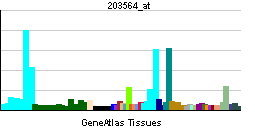FANCG
| Fanconi anemia, complementation group G | |||||||||||
|---|---|---|---|---|---|---|---|---|---|---|---|
| Identifiers | |||||||||||
| Symbols | FANCG ; FAG; XRCC9 | ||||||||||
| External IDs | Template:OMIM5 Template:MGI HomoloGene: 3402 | ||||||||||
| |||||||||||
| RNA expression pattern | |||||||||||
 | |||||||||||
| More reference expression data | |||||||||||
| Orthologs | |||||||||||
| Template:GNF Ortholog box | |||||||||||
| Species | Human | Mouse | |||||||||
| Entrez | n/a | n/a | |||||||||
| Ensembl | n/a | n/a | |||||||||
| UniProt | n/a | n/a | |||||||||
| RefSeq (mRNA) | n/a | n/a | |||||||||
| RefSeq (protein) | n/a | n/a | |||||||||
| Location (UCSC) | n/a | n/a | |||||||||
| PubMed search | n/a | n/a | |||||||||
Fanconi anemia, complementation group G, also known as FANCG, is a human gene.[1]
FANCG, involved in Fanconi anemia, confers resistance to both hygromycin and mitomycin C. FANCG contains a 5-prime GC-rich untranslated region characteristic of housekeeping genes. The putative 622-amino acid protein has a leucine-zipper motif at its N-terminus. Fanconi anemia is an autosomal recessive disorder with diverse clinical symptoms, including developmental anomalies, bone marrow failure, and early occurrence of malignancies. A minimum of 8 FA genes have been identified. The FANCG gene is responsible for complementation group G.[1]
References
Further reading
- Liu N, Lamerdin JE, Tucker JD; et al. (1997). "The human XRCC9 gene corrects chromosomal instability and mutagen sensitivities in CHO UV40 cells". Proc. Natl. Acad. Sci. U.S.A. 94 (17): 9232–7. PMID 9256465.
- Joenje H, Oostra AB, Wijker M; et al. (1997). "Evidence for at least eight Fanconi anemia genes". Am. J. Hum. Genet. 61 (4): 940–4. PMID 9382107.
- de Winter JP, Waisfisz Q, Rooimans MA; et al. (1998). "The Fanconi anaemia group G gene FANCG is identical with XRCC9". Nat. Genet. 20 (3): 281–3. doi:10.1038/3093. PMID 9806548.
- Garcia-Higuera I, Kuang Y, Näf D; et al. (1999). "Fanconi anemia proteins FANCA, FANCC, and FANCG/XRCC9 interact in a functional nuclear complex". Mol. Cell. Biol. 19 (7): 4866–73. PMID 10373536.
- Jelesko JG, Harper R, Furuya M, Gruissem W (1999). "Rare germinal unequal crossing-over leading to recombinant gene formation and gene duplication in Arabidopsis thaliana". Proc. Natl. Acad. Sci. U.S.A. 96 (18): 10302–7. PMID 10468603.
- Waisfisz Q, de Winter JP, Kruyt FA; et al. (1999). "A physical complex of the Fanconi anemia proteins FANCG/XRCC9 and FANCA". Proc. Natl. Acad. Sci. U.S.A. 96 (18): 10320–5. PMID 10468606.
- Kruyt FA, Abou-Zahr F, Mok H, Youssoufian H (1999). "Resistance to mitomycin C requires direct interaction between the Fanconi anemia proteins FANCA and FANCG in the nucleus through an arginine-rich domain". J. Biol. Chem. 274 (48): 34212–8. PMID 10567393.
- Reuter T, Herterich S, Bernhard O; et al. (2000). "Strong FANCA/FANCG but weak FANCA/FANCC interaction in the yeast 2-hybrid system". Blood. 95 (2): 719–20. PMID 10627486.
- Huber PA, Medhurst AL, Youssoufian H, Mathew CG (2000). "Investigation of Fanconi anemia protein interactions by yeast two-hybrid analysis". Biochem. Biophys. Res. Commun. 268 (1): 73–7. doi:10.1006/bbrc.1999.2055. PMID 10652215.
- Yamada T, Tachibana A, Shimizu T; et al. (2000). "Novel mutations of the FANCG gene causing alternative splicing in Japanese Fanconi anemia". J. Hum. Genet. 45 (3): 159–66. PMID 10807541.
- Kuang Y, Garcia-Higuera I, Moran A; et al. (2000). "Carboxy terminal region of the Fanconi anemia protein, FANCG/XRCC9, is required for functional activity". Blood. 96 (5): 1625–32. PMID 10961856.
- Garcia-Higuera I, Kuang Y, Denham J, D'Andrea AD (2000). "The fanconi anemia proteins FANCA and FANCG stabilize each other and promote the nuclear accumulation of the Fanconi anemia complex". Blood. 96 (9): 3224–30. PMID 11050007.
- de Winter JP, van der Weel L, de Groot J; et al. (2000). "The Fanconi anemia protein FANCF forms a nuclear complex with FANCA, FANCC and FANCG". Hum. Mol. Genet. 9 (18): 2665–74. PMID 11063725.
- Demuth I, Wlodarski M, Tipping AJ; et al. (2000). "Spectrum of mutations in the Fanconi anaemia group G gene, FANCG/XRCC9". Eur. J. Hum. Genet. 8 (11): 861–8. doi:10.1038/sj.ejhg.5200552. PMID 11093276.
- Medhurst AL, Huber PA, Waisfisz Q; et al. (2001). "Direct interactions of the five known Fanconi anaemia proteins suggest a common functional pathway". Hum. Mol. Genet. 10 (4): 423–9. PMID 11157805.
- McMahon LW, Sangerman J, Goodman SR; et al. (2001). "Human alpha spectrin II and the FANCA, FANCC, and FANCG proteins bind to DNA containing psoralen interstrand cross-links". Biochemistry. 40 (24): 7025–34. PMID 11401546.
- Yagasaki H, Adachi D, Oda T; et al. (2002). "A cytoplasmic serine protein kinase binds and may regulate the Fanconi anemia protein FANCA". Blood. 98 (13): 3650–7. PMID 11739169.
- Futaki M, Igarashi T, Watanabe S; et al. (2002). "The FANCG Fanconi anemia protein interacts with CYP2E1: possible role in protection against oxidative DNA damage". Carcinogenesis. 23 (1): 67–72. PMID 11756225.
- van de Vrugt HJ, Koomen M, Berns MA; et al. (2002). "Characterization, expression and complex formation of the murine Fanconi anaemia gene product Fancg". Genes Cells. 7 (3): 333–42. PMID 11918676.
- Pace P, Johnson M, Tan WM; et al. (2002). "FANCE: the link between Fanconi anaemia complex assembly and activity". EMBO J. 21 (13): 3414–23. doi:10.1093/emboj/cdf355. PMID 12093742.
| This protein-related article is a stub. You can help Wikipedia by expanding it. |